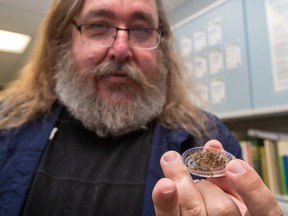“The downside to the drier conditions means that there’s a lot fewer other organisms as well,” Jenkins said.

Article content
Every year, when the snow melts and the spring weather warms, Edmontonians begin to ask an important question: how bad will the mosquitoes be this year?
While some years have seen large scourges of mosquitos around the city, a senior scientist with the City of Edmonton says this year’s dry conditions and minimal snowfall mean that 2024 will be relatively light when it comes to those annoying bloodsuckers.
Advertisement 2
Article content
Article content
“The last several spring seasons have been very low in terms of mosquito populations,” said Michael Jenkins, senior scientist with the City of Edmonton, on Wednesday.
“We’re expecting similar this year. We’re not seeing a lot of habitats out there and even where we are finding water, we’re not finding a lot of mosquito activity in those ponds yet.”
Jenkins sais that for the next few months, the city will control the mosquito population by applying pesticides targeting aquatic larvae, focusing on roadside ditches, industrial areas, ravines, and open water found in city fields. He says that while the weather is dry now, one strong rainfall could cause a sudden exponential increase in the population of the vampiric insects.
“It’s really hard to predict without knowing what’s going to happen in terms of rainfall. If we get lots of rain, we got lots of mosquitoes. If it’s warm, we get more activity of mosquitoes as well.”
Not all good news for Edmonton’s ecosystem
The lowered mosquito population may be good news for people not having to scratch their itchy skin so often, but Jenkins says it can be detrimental to the health of our insect ecosystem. There are about 30 species of mosquitoes in the Edmonton area, most referred to as floodwater species, according to Jenkins. Predators like dragonfly nymphs, birds, and fish feed on mosquitoes and other small insects in “permanent bodies of water” like rivers and lakes, which the city does not treat for mosquitoes.
Article content
Advertisement 3
Article content
“The downside to the drier conditions means that there’s a lot fewer other organisms as well,” Jenkins said.
“Things like midges, phantom midges, these are important food sources for a lot of things and birds. These conditions generally mean that it’s more difficult for swallows and other different birds to find food.”
West Nile Awareness
In 2023, a new species of mosquito, culex pipiens — also known as the common house mosquito — found its way to the city. Unlike other breeds of mosquito, the culex pipiens are able to lay eggs on stagnant water, regardless of whether there is vegetation around it. These mosquitoes are especially dangerous, because they are known for transmitting the West Nile virus.
Those who are bitten by a mosquito carrying the virus can develop West Nile non-neurological syndrome (formerly known as West Nile fever) or the more serious West Nile neurological syndrome. Symptoms of non-neurological syndrome can include fever, chills, nausea, vomiting, fatigue, skin rash, swollen glands and headache.
Alberta Health Services has previously said that most infected by the virus won’t even know it, while about one in five will develop West Nile non-neurological syndrome, which can happen up to 14 days after a bite.
Advertisement 4
Article content
The one-in-100 who develops the neurological syndrome may experience tremors, drowsiness, confusion, swallowing problems, high fever, unconsciousness and paralysis. In rare cases, the infection can be fatal.
How to stay safe from West Nile
According to AHS, you can minimize the risk of mosquito bites by a wearing long-sleeved, light-coloured shirt, staying indoors at dawn and dusk, using a Health Canada-approved insect repellent, like products that contain DEET or Icaridin for anyone older than six months.
Albertans can learn more about West Nile virus and ways to keep safe by visiting www.fightthebite.info or calling Health Link at 811.
Recommended from Editorial
Article content





